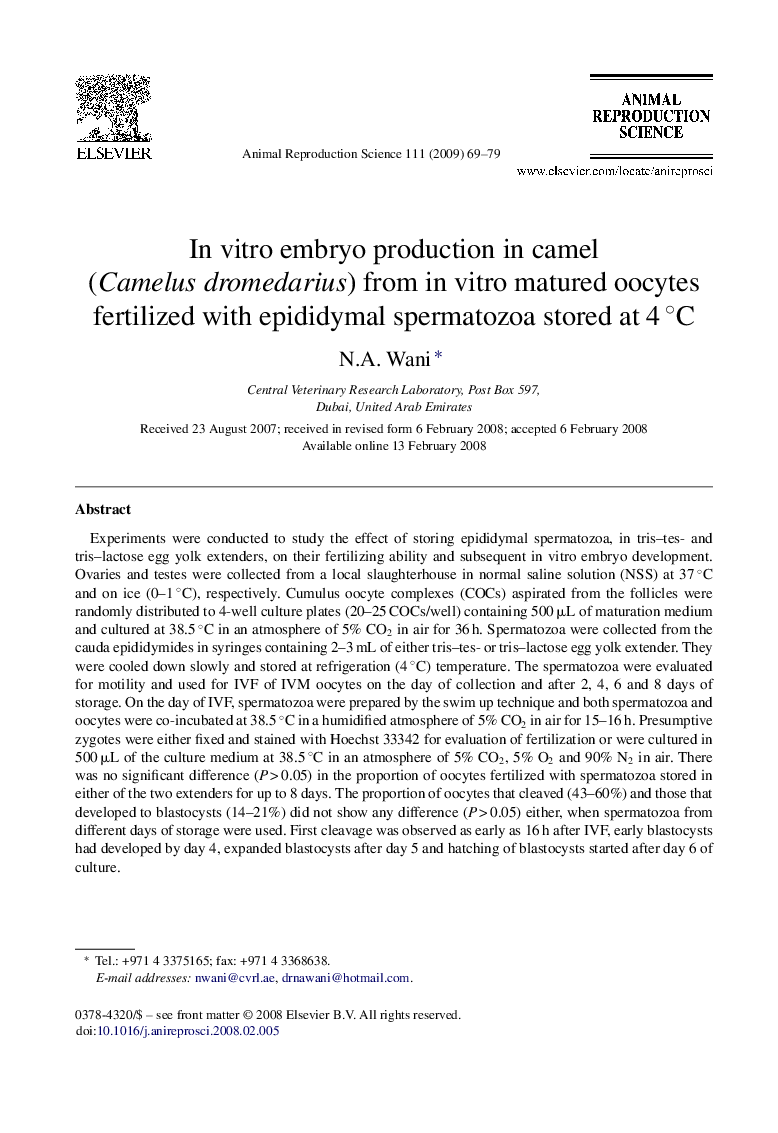| کد مقاله | کد نشریه | سال انتشار | مقاله انگلیسی | نسخه تمام متن |
|---|---|---|---|---|
| 2074146 | 1079076 | 2009 | 11 صفحه PDF | دانلود رایگان |

Experiments were conducted to study the effect of storing epididymal spermatozoa, in tris–tes- and tris–lactose egg yolk extenders, on their fertilizing ability and subsequent in vitro embryo development. Ovaries and testes were collected from a local slaughterhouse in normal saline solution (NSS) at 37 °C and on ice (0–1 °C), respectively. Cumulus oocyte complexes (COCs) aspirated from the follicles were randomly distributed to 4-well culture plates (20–25 COCs/well) containing 500 μL of maturation medium and cultured at 38.5 °C in an atmosphere of 5% CO2 in air for 36 h. Spermatozoa were collected from the cauda epididymides in syringes containing 2–3 mL of either tris–tes- or tris–lactose egg yolk extender. They were cooled down slowly and stored at refrigeration (4 °C) temperature. The spermatozoa were evaluated for motility and used for IVF of IVM oocytes on the day of collection and after 2, 4, 6 and 8 days of storage. On the day of IVF, spermatozoa were prepared by the swim up technique and both spermatozoa and oocytes were co-incubated at 38.5 °C in a humidified atmosphere of 5% CO2 in air for 15–16 h. Presumptive zygotes were either fixed and stained with Hoechst 33342 for evaluation of fertilization or were cultured in 500 μL of the culture medium at 38.5 °C in an atmosphere of 5% CO2, 5% O2 and 90% N2 in air. There was no significant difference (P > 0.05) in the proportion of oocytes fertilized with spermatozoa stored in either of the two extenders for up to 8 days. The proportion of oocytes that cleaved (43–60%) and those that developed to blastocysts (14–21%) did not show any difference (P > 0.05) either, when spermatozoa from different days of storage were used. First cleavage was observed as early as 16 h after IVF, early blastocysts had developed by day 4, expanded blastocysts after day 5 and hatching of blastocysts started after day 6 of culture.It may be concluded that dromedary epididymal spermatozoa survive in storage for at least 8 days in tris–lactose- and tris–tes egg yolk diluents at 4 °C. These spermatozoa maintain fertilizing ability and may be suitable for use in IVF and other assisted reproductive procedures.
Journal: Animal Reproduction Science - Volume 111, Issue 1, March 2009, Pages 69–79